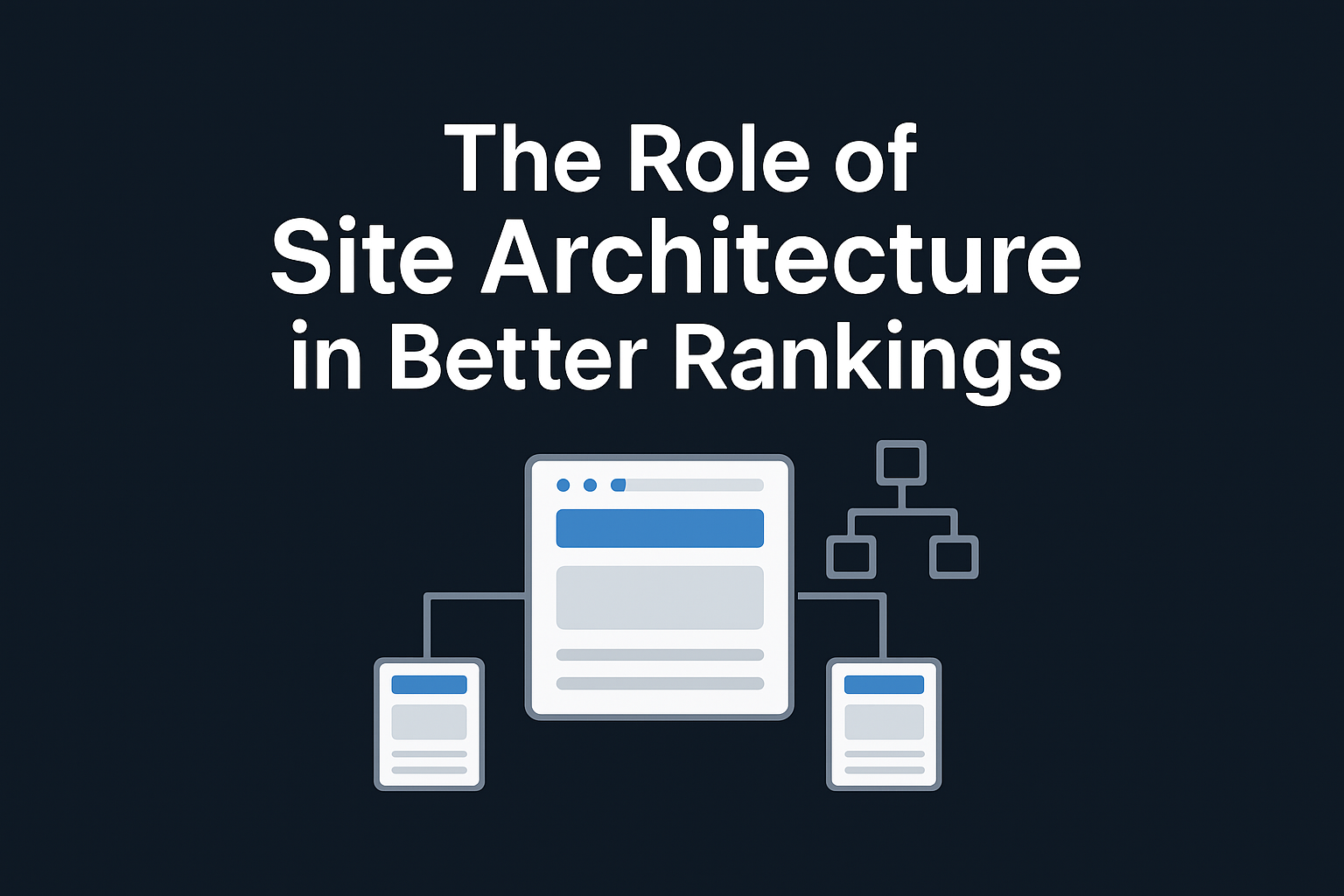A website’s success depends on more than just good content or strong backlinks.
The structure of the site plays a vital role in how search engines and users interact with it.
When the architecture is designed correctly, it not only improves visibility in search results but also makes navigation smoother for visitors.
A strong structure reduces confusion, strengthens topical relevance, and ensures that important pages get the attention they deserve.
In short, the way a website is built impacts how well it performs online.
What is Site Architecture?
Site architecture describes the way a website’s pages are arranged and linked together through menus, navigation paths, and internal connections.
It defines the hierarchy of information and ensures that users and search engines can easily find what they’re looking for.
A logical and simple structure benefits SEO because it distributes link equity, highlights priority pages, and prevents duplicate or orphaned content.
At the same time, it improves user experience by reducing the number of clicks needed to reach key pages.
The right structure can be the deciding factor between a site that ranks high and one that struggles to gain attention.
The Role of Site Architecture in Stronger Rankings and User Experience
Here are the key reasons site architecture matters for both search engines and users.
A structured layout improves crawling, ranking signals, and navigation while reducing errors and confusion.
1. Clear Hierarchical Structure
A well-defined hierarchy allows search engines to recognize the value and priority of each page.
By arranging content into categories and subcategories, you make it easier to show which topics are central.
For example, an e-commerce store can divide its structure into main categories like “Men,” “Women,” and “Kids,” each with its own subcategories.
This organization ensures crawlers can easily follow paths and assign value to deeper pages.
Users also benefit because they can reach their desired section without feeling lost.
Without a hierarchy, search engines may struggle to index pages properly, reducing your chances of ranking well.

2. Internal Linking Strategy
Internal links create pathways between related pages, which helps distribute authority across the site.
When done strategically, it ensures that not only your homepage but also important product or service pages gain visibility.
For instance, linking blog articles to related services shows relevance and strengthens ranking signals.
A balanced internal linking structure reduces the chances of having orphan pages, which search engines ignore.
For users, these links encourage further browsing, increasing time spent on the site.
A scattered or broken linking strategy, on the other hand, confuses crawlers and weakens SEO performance significantly.
3. Crawl Efficiency
Search engines use bots to crawl and index websites. If your site architecture is disorganized, crawlers may miss important pages.
A well-planned structure ensures that bots can move seamlessly, indexing all valuable content without hitting dead ends.
Creating an XML sitemap and ensuring proper navigation further improves crawl efficiency.
Large sites, like e-commerce stores, often face crawling challenges, but a flat and logical structure makes the process easier.
When search engines can crawl efficiently, your chances of ranking for targeted keywords increase, and duplicate content issues are reduced.
4. User Experience
A website needs to be designed in a way that supports both search engines and the people who visit it.
If the structure confuses visitors, they will leave quickly, which increases bounce rates.
Good architecture ensures that visitors can find information within three clicks or fewer.
A clear navigation menu, breadcrumbs, and logical content flow all contribute to this.
The result is higher engagement, more conversions, and stronger trust in your brand.
Search engines pick up on these signals and reward sites that keep visitors engaged.
Poor architecture, however, frustrates users and pushes them toward competitors, no matter how strong the content may be.

5. URL Structure
URLs are often overlooked, but they play a significant role in site architecture.
A short and meaningful URL helps visitors and search engines quickly understand the purpose of a page. For example, “/services/web-design” is clearer than “/page?id=12.”
Organized URLs reflect the hierarchy of your website and help in keyword targeting. Search engines can also index clean URLs faster.
Avoiding unnecessary parameters and numbers prevents confusion and improves trustworthiness.
A well-structured URL system not only aids SEO but also makes sharing links easier on social media or other platforms.
6. Page Depth
Page depth shows the number of clicks needed to access a page from the homepage.
The deeper the page, the less likely it is to be crawled frequently. Key pages should be reachable in three clicks or fewer for better indexing.
A flat architecture keeps valuable pages closer to the surface, increasing their chances of ranking higher.
Deeply buried pages often fail to get indexed, wasting potential content.
Balancing the depth ensures a smooth experience for both crawlers and users, which directly contributes to stronger SEO performance.
7. Avoiding Duplicate Content
Duplicate content often appears when poor site architecture allows the same information to be accessed through multiple URLs or when product variations create very similar pages.
This issue confuses search engines, which struggle to decide which version should rank.
As a result, authority signals get split, weakening performance across all duplicates.
Strong architecture prevents this by maintaining consistent pathways, using categories properly, and applying filters in a controlled way.
Canonical tags should also be used when necessary to guide search engines toward the preferred version.
Each page must serve a unique purpose to strengthen credibility and maintain ranking power.

8. Mobile-Friendly Navigation
With the majority of users browsing through smartphones, mobile-friendly navigation has become a critical part of site architecture.
Large menus or structures that look fine on desktops often fail on smaller screens.
Responsive design, collapsible menus, and touch-friendly navigation help keep content accessible without overwhelming the user.
Search engines also prioritize mobile-first indexing, meaning the mobile version is the primary source for ranking.
Simplifying navigation for mobile ensures users can find what they need in fewer clicks, while crawlers can process the site without difficulty.
A mobile-ready structure is no longer optional; it is now essential for SEO success.
9. Site Speed and Performance
A site’s loading speed is directly tied to its structure. Complex pathways, unnecessary redirects, or heavy coding slow down performance.
Both users and search engines expect fast-loading pages, so delays result in higher bounce rates and weaker rankings.
Clean architecture, supported with compressed files and logical menus, helps keep performance efficient.
Fast websites encourage users to stay longer and engage more, which indirectly supports SEO.
Avoiding bottlenecks and keeping the structure lean allows content to load smoothly.
When navigation is efficient and coding is optimized, the site not only performs better but also ranks higher in search results.
10. Topical Relevance
Well-planned architecture establishes topical relevance by organizing related pages into structured groups.
When content on similar subjects is clustered together, it signals to search engines that the website covers those areas in depth.
For example, service pages, blog posts, and guides on the same subject should be interlinked within a hub, strengthening contextual signals.
This type of grouping shows authority and creates a logical flow for users as well.
Without clear topical organization, content appears scattered and may struggle to dominate keywords.
A structured approach improves both ranking opportunities and user understanding across specific subject areas.

11. Reduced Bounce Rate
Bounce rate is often linked to the website’s structure. If visitors cannot find the information they need quickly, they often leave after viewing just one page.
A clear and logical structure improves navigation, encouraging users to explore further.
Features like breadcrumbs, related content links, and easy-to-follow menus keep people engaged.
When users spend more time on the site, it signals to search engines that the content is valuable and relevant.
When bounce rates drop, it signals stronger engagement, which supports better rankings and more conversions.
Site architecture plays a direct role in creating pathways that keep users active instead of leaving immediately.
12. Easier Scalability
Websites naturally grow with time, adding new content, categories, or products.
Without a flexible architecture, this expansion leads to clutter and confusion.
A scalable structure ensures that new sections can be added smoothly without disrupting existing navigation.
Search engines also benefit, as crawlers can continue indexing new content without errors or duplication.
For businesses, scalability reduces long-term maintenance issues and allows growth without technical setbacks.
An architecture designed for expansion keeps the site organized and user-friendly as it evolves.
Scalability is not just about adding more pages; it’s about ensuring consistent SEO strength over the long term.

How can Brandout’s custom web development services create scalable site architecture for stronger SEO and user experience?
Brandout’s custom web development service builds scalable site architecture through structured navigation, clean URL frameworks, and optimized internal linking.
This ensures search engines crawl efficiently while users enjoy smooth navigation, directly supporting stronger SEO and a better experience.
Conclusion
Site architecture is the backbone of every website. From navigation and crawlability to topical relevance and scalability, every aspect of structure directly influences rankings.
Well-planned architecture improves visibility, boosts user satisfaction, and reduces technical problems.
On the other hand, weak architecture can hold back even the most valuable content.
Any business aiming for online growth should consider site architecture a core element rather than leaving it as a secondary concern.
Investing in the right structure is one of the smartest ways to secure long-term SEO growth and stronger digital performance.
FAQs
Why is site architecture important for SEO?
It helps search engines crawl, index, and understand content more efficiently. A strong structure improves rankings while also guiding users smoothly.
How many clicks should it take to reach important pages?
Ideally, users and search engines should be able to reach important pages within three clicks from the homepage to maximize visibility.
What’s the difference between flat and deep site architecture?
Flat architecture keeps key pages closer to the homepage, while deep architecture buries them under multiple layers. Flat is generally better for SEO.
Can poor site architecture affect user trust?
Yes, if visitors struggle to find information, they lose confidence in the website and may move to competitors, hurting both rankings and conversions.




